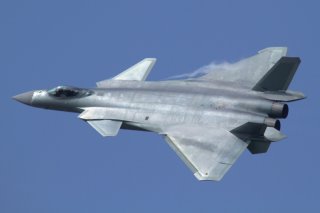China to Unveil Two-Seat J-20 Stealth Fighter Variant
The J-20 “Mighty Dragon” is China’s first operational stealth aircraft.
China has announced plans to begin production of a new two-seat variant of the Chengdu J-20 fifth-generation fighter that would, according to Chinese officials, dramatically increase the platform’s offensive capabilities. This announcement comes on the heels of China’s other significant J-20 announcement this week, relating to China’s decision to stop sourcing Russian engines for their stealth fighter. China will instead modify an existing domestic power plant for its purposes.
The J-20 “Mighty Dragon” is China’s first operational stealth aircraft, entering active service in March of 2017. The J-20 is indeed stealthy, though there remains some debate about just how effective the jet’s design may be. Some still argue that its front canards could potentially offer a weapons-grade lock on the jet when it’s flying horizontally across an aircraft’s field of view. Like all other fifth-generation fighters, the J-20 isn’t just sneaky, it also boasts a secure data link and the sort of advanced avionics one might expect from a data-fusing flying computer of its ilk. It has, however, suffered from long delays in its purpose-built engine program, forcing the Chinese to utilize Russian-sourced AL-31F engines.
Earlier this week, China announced plans to stop using the Russian power plant and to discontinue efforts on their purpose-built WS-15 engine that had been slated for the advanced fighter. Instead, China will now work to modify its existing fourth-generation fighter engine, the WS-10C, for the stealth jet. According to Chinese claims, the WS-10C will be as capable as the Pratt & Whitney F119 engine that powers America’s top air superiority fighter, the F-22 Raptor. This goal is hardly surprising, as the development of the J-20 was based largely on stolen plans for the F-22 in the first place.
The planned engine change is intended to offer the J-20 the same sort of thrust vector control the Raptor uses for acrobatic maneuvers during aerial warfare–a change that was already announced for the J-20B currently in production. In order to match the F-22, these modified engines will also have to offer super-cruising capabilities, or the ability to maintain supersonic speeds without the use of an afterburner, on par with that offered by the Raptor. Supercruising allows a fighter to fly further faster, while still keeping enough gas in its tank for a lengthy fight once it arrives.
But new engines aren’t the biggest change on the horizon for China’s J-20. A design change of a much broader stroke announced by the Chinese government earlier this week would see the aircraft modified to serve as a fighter bomber, adding a second seat in the cockpit for an onboard weapons officer and potentially increasing the aircraft’s payload capacity as a result of the design changes required to accommodate another crew member.
Every 5th generation fighter in operation on the planet is a single-seat aircraft, from the original F-22 Raptor to the advanced F-35 Joint Strike Fighter and even Russia’s troubled Sukhoi Su-57 Felon. It’s unlikely that China will produce only two-seat J-20 variants in the future, but the addition of a J-20 fighter bomber could offer a new level of capability to China’s People’s Liberation Army.
Single-seat aircraft tend to be smaller and highly capable in the air, and while all fifth-generation fighters are considered multi-role in their range of capabilities, a two-seat J-20 could improve the aircraft’s survivability in contested airspace as well as its ability to effectively engage ground targets.
While a single-seat fighter has one operator tasked with managing everything from flying the jet to identifying and engaging targets, two-seat fighters have a second crew member to offload some of those responsibilities on. Most two-seat fighters utilize a single pilot and a second weapons officer (think Maverick and Goose, respectively, in Top Gun). While the pilot manages the battlespace, the weapons officer or co-pilot can manage weapons systems, communications, and electronic warfare capabilities.
Two-seat fighters are, however, much heavier than single-seat jets on average, so the added capability comes with a trade-off in performance.
“An upgraded twin-seat J-20 could carry more offensive weapons and have stronger air-to-ground attack capabilities, so … it would become both a fighter and a bomber,” Song Zhongping, a former PLA instructor, said to the South China Morning Post.
Of course, building a two-seat J-20 isn’t as simple as just stretching the fuselage and bolting a new chair in. The aircraft itself will likely have to undergo significant modifications to support both the new crew member and any added capabilities the PLA wants incorporated into a new J-20 fighter bomber.
If China manages to bring its WS-10C engine into full fifth-generation maturity, it will offer a significant capability increase for the fighter itself, and it will almost certainly find a home in the two-seat J-20 as well. However, despite China’s headline-grabbing announcements over the past week, all of these changes should be regarded as notional at best right now. Of course, that doesn’t mean to discount the potential capability of the J-20 in the future, but as far as claims about military superiority go, China’s reputation is almost as compromised as Russia’s.
This article first appeared at Sandboxx.
Image: Wikipedia..

